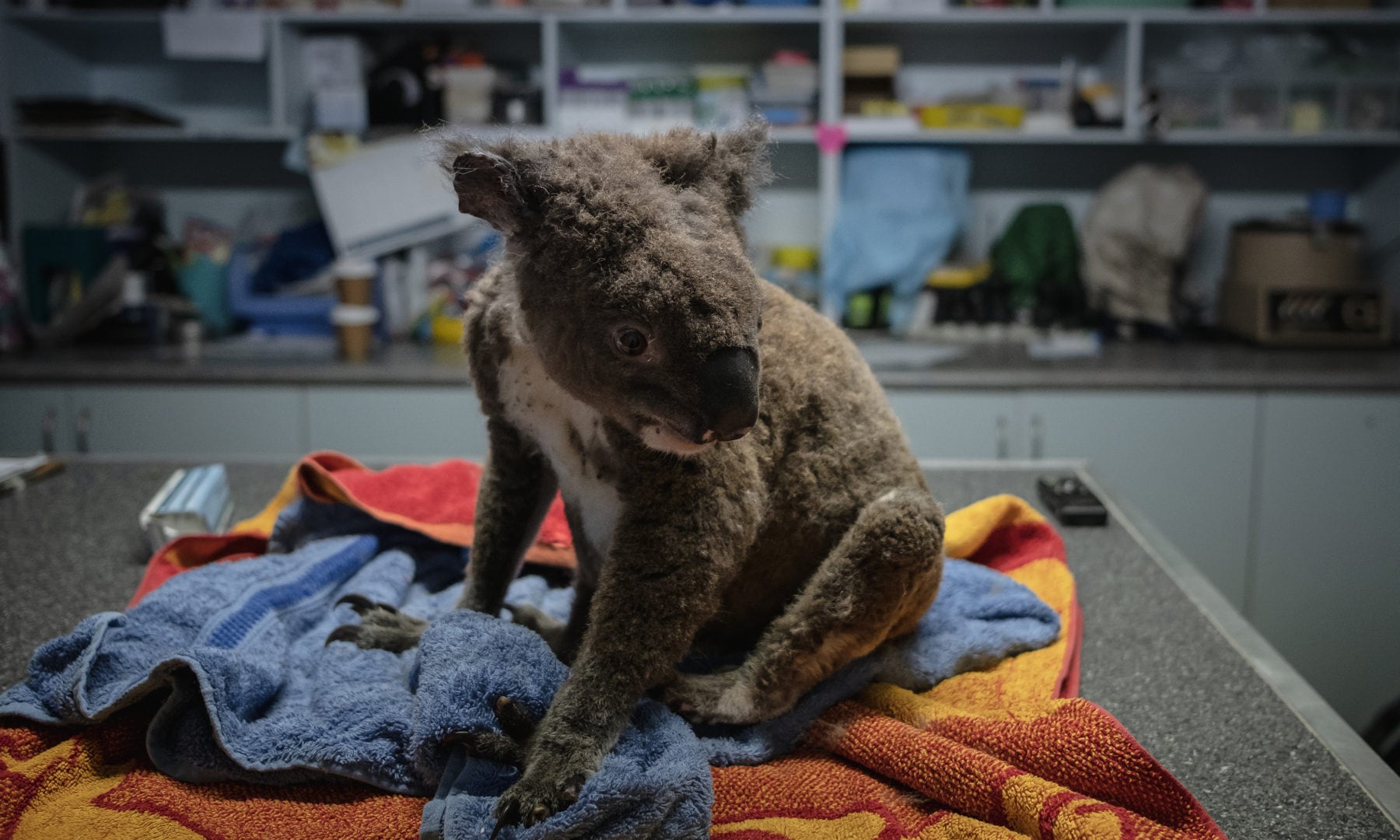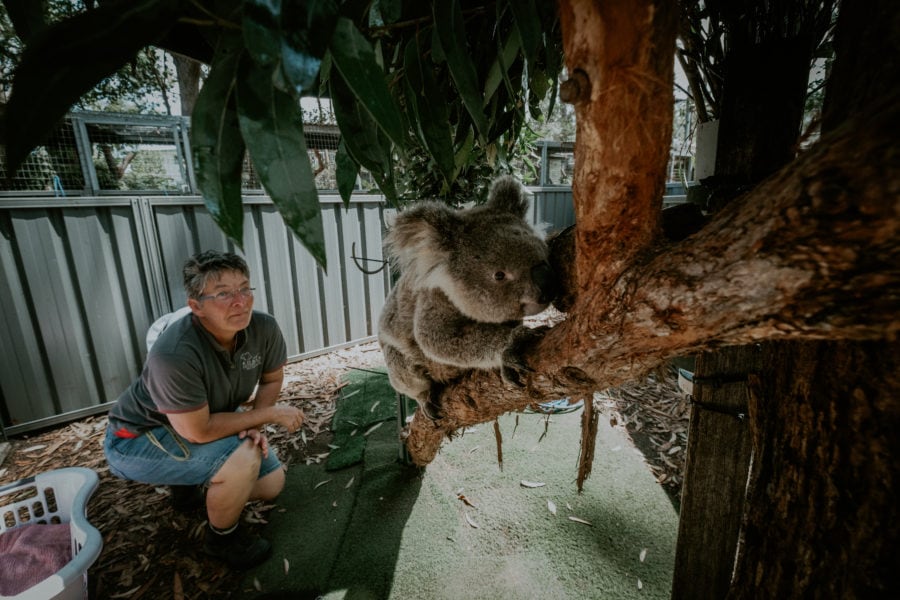When Paul was handed to Barbara Barrett in a washing basket to take home last November, he was given a slim chance of survival. He lay curled up in a ball on old towels, burnt, traumatised and barely moving.
“We thought he might not make it,” Barb, a koala carer with two decades experience, recalls of the young male koala. But there was a chance, so he was patched up, made comfortable and entrusted to her to try to rehabilitate him.
He’d been rescued by a man named Paul, hence his adopted name, from a still-smouldering fireground near Port Macquarie, on the New South Wales mid-north coast, after one of the first of the fires that went on to rage throughout summer across south-eastern Australia.
His ears were singed and the fur on his rump and quite a few of the nails on his paws had been burnt. Some of the claws dropped off a few weeks later meaning that, if he did survive, climbing vertically up a tree trunk would be near impossible.
His thick protective coat was still intact across much of the rest of his body, protecting his skin as it should have from direct searing. But it was thought likely that, because he was singed, he would have radiant burns beneath it caused by the intense heat of the fire he’d survived.
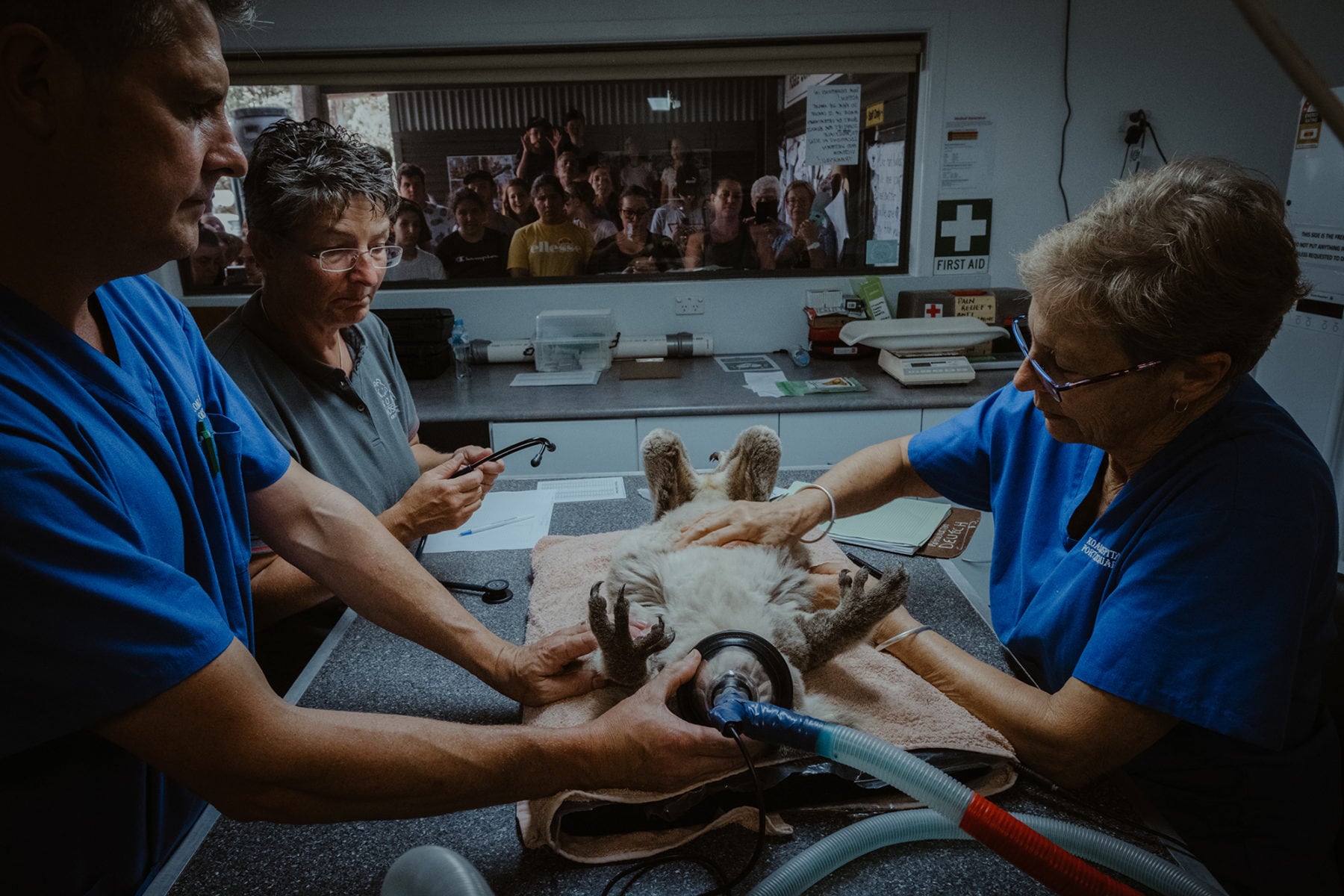
Inside the Port Macquarie Koala Hospital
Ultimately more than 16 million hectares of bushland, much of it national park, state forest or world heritage area, burnt.
The world watched in horror and understandably wept along with Australia at the tragic loss of human life and properties that resulted. But perhaps what was unexpected was the widespread and heartfelt dismay about what the fires – hotter and more widespread than anything seen before – were doing to Australia’s largely unique biodiversity.
Leading ecologists around the country, including the University of Sydney’s Professor Chris Dickman, did untold interviews with media outlets from dozens of countries as it became clear what the planet could be losing forever in the Australian bushfires.
Based on animal density measurements that he’d made in NSW forests during unrelated research before the fires, Chris calculated that at least 800 million individual animals were killed in the NSW fires alone.
That figure, he determined, could realistically be extrapolated to the other states affected by the crisis – Victoria, Queensland, South Australia and Western Australia – to more than a billion. “And that was just terrestrial mammals, birds and reptiles,” he says. “It doesn’t even take into account forest bats, frogs and fish.”
Chris and some of his esteemed colleagues quickly got together and estimated that between 20 and 100 species of vertebrate animals and plants would be pushed close to the brink of extinction. This included the long-footed potoroo, greater glider, Kangaroo Island dunnart, black-tailed dusky antechinus, silver-headed antechinus and Hastings River mouse.
Professor Mike Lee, an evolutionary biologist at Flinders University, SA, estimated that the number of insect species that could now be facing extinction was 700.
While the koala was not on any of these lists, the species quickly became the symbol of all that precious and largely unique Australian biodiversity being pushed very close to the edge by the fires.
Heart-wrenching social media footage went viral of a quintessential teddy bear-like koala crying in pain as a woman rescued it from a charred and smouldering forest on the NSW north coast, literally giving up her shirt to wrap around its badly burnt body.
Later, from the Cooma area, south of Canberra, came reports of screaming koalas falling like fireballs from burning trees.
The focus of attention for a massive outpouring of grief, both nationally and internationally, for Australia’s native animals quickly became the Port Macquarie Koala Hospital, a facility set up in 1973 as Australia’s first wildlife hospital and now staffed by more than 150 volunteers.
The first koala burns victim from the recent tragedy was Paul, who was brought in on 2 November, after which the hospital became a frenetic hub of activity for at least the next 12 weeks.
November is normally quiet for the hospital, but 50,000 people filed though its gates that month after the first images of Paul went around the world. And what they witnessed through the hospital treatment room’s public viewing window was a “conveyor belt” of burnt koalas, says clinical director Cheyne Flanagan.
They also saw burned kangaroos, possums and turtles coming through as an overwhelmed FAWNA, a wildlife rescue facility on the NSW mid-north coast, also sent animals the hospital’s way.
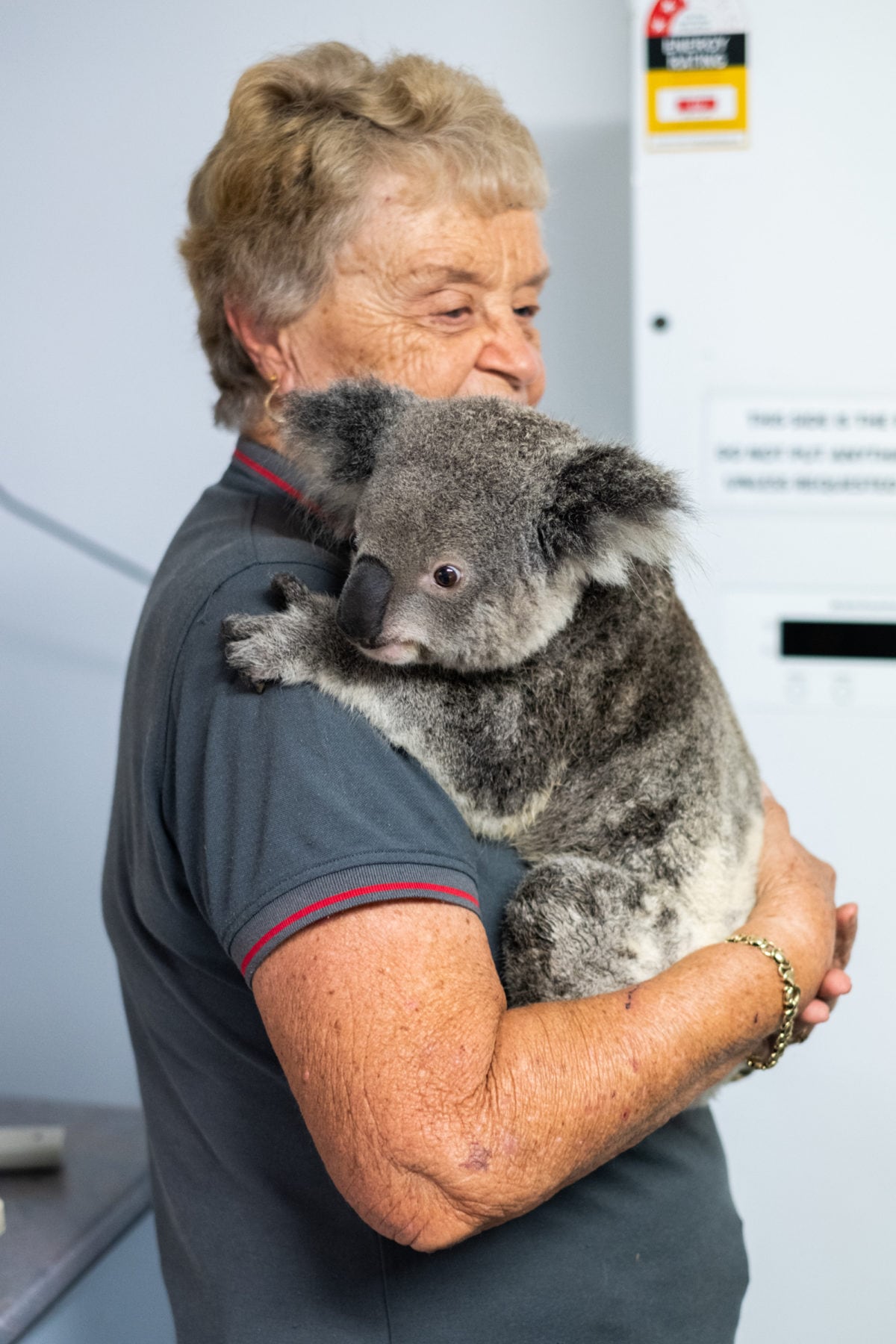
Daily visitor numbers continued to be up by 50–75 per cent for the hospital over the following months, about a quarter of which were from overseas, says Sue Ashton, president of both the hospital and Koala Conservation Australia.
During the crisis, followers on the hospital’s Facebook site rose from 27,000 to 150,000. The hospital offers koala “adoptions” at $60 each to help raise funds and usually does no more than 300 a month. From 30 October to mid-January it processed 70,000. At the time of going to press it was still handling 1500 a day.
“Every time a film crew comes here, and we’ve had them from around the world since the fires began, the adoptions roll in shortly after from wherever they came from – Japan, China, London, Saudi Arabia,” Sue says.
About 70 animals are cared for at the facility at any one time and its enclosures have been fully occupied since the fires began. Many koala joeys and quite a few older animals requiring specialist attention have also been cared for at the homes of trained carers. On average, koalas remain at the hospital for a month before being returned to the wild, as close as possible to where they were found.
Deaths of koalas in the northern NSW area as a direct result of the fires are said to be in their thousands, leaving what Cheyne will only describe, until full scientific surveys have been completed, as “a very small percentage” of the original northern NSW population.
There is, however, an extraordinarily positive outcome that’s come out of the devastation.
All the publicity has meant that the koala hospital has raised more than $7 million on a GoFundMe page set up to handle the overwhelming level of donations that were besieging hospital volunteers. And that means the hospital is now able to embark on a wild koala breeding program, which it has had in the planning for several years.
“The hospital is partnering with the University of Sydney, Australian Museum, Taronga Zoo, Billabong Zoo and the NSW government to get this happening,” explains Cheyne, who’s been a major force behind the project. Infrastructure for the program is expected to start before the end of the year.
“We’re going to mimic what will happen in the wild and we’ll do that following strict scientific protocols and methodology,” Cheyne says. “There will be three breeding facilities, separate from each as insurance in case of bushfires and the whole program will follow a ‘studbook’ system. Koalas will only be mated with koalas of the same provenance to maintain good genetic integrity. All offspring will be returned to the wild into well-managed, conserved habitats.”
Rebuilding and retaining the number of animals living in this area is seen as hugely important. Along with koalas in the Blue Mountains, which have also lost much of their habitat from these fires, the northern NSW and south-eastern Queensland koala populations are seen as particularly important to the survival of the species. And the reason why is that research has shown they are the country’s most genetically diverse.
The koala genome project
The realisation about the genetic significance of the northern NSW and Queensland populations grew out of the koala genome project, which for the first time detailed the species’ genetic makeup.
This huge undertaking, completed in mid-2018, was spearheaded by Dr Rebecca Johnson, director of the Australian Museum Research Institute, and involved collaboration from a large number of genetics and koala researchers from a wide range of research bodies.
Field researchers and wildlife carers, including those at the koala hospital, have been arguing that the conservation status of koalas should be upgraded from vulnerable, which is currently its status across much of the species range, to endangered. This would provide a higher legal level of protection for known koala habitat.
But there has been a problem of perception. Koalas are plentiful in Victoria and SA. “But quantity does not mean quality,” Rebecca says. “All the animals in SA and a lot in Victoria are inbred. So they’re not the ideal populations you’d want to use to rescue the species if it reached a highly endangered, about-to-go-extinct scenario.”
And what the current bushfire crisis has revealed is that we certainly need to prepare for the possibility of a natural disaster bringing on exactly that sort of scenario with a woodland and forest species such as the koala.
Research based on the genome’s findings has identified which koala populations would be the best to maintain to safeguard the species. “And it’s those populations around south-eastern Queensland, Port Macquarie and Coffs Harbour – all of those southern Queensland and northern coastal NSW populations – that are really diverse,” Rebecca says. And those are exactly the populations that have been decimated by the recent fires.
Some of the 26,000 genes identified in the koala genome project also help explain the koala’s extraordinary ability to survive almost exclusively on eucalypt leaves, a diet high in toxic terpenes and phenols.
Researchers found an abundance of genes for bitter taste receptors, which would allow koalas to identify the least toxic leaves, as well as genes that could detoxify the poisonous substances. “So they have this super detox capability that allows them to eat a highly toxic diet,” Rebecca explains.
Koalas are fussy eaters and different populations prefer the leaves of different eucalypt species. Many Victorian populations, for example, love manna gums. Different northern NSW populations choose a wider variety of eucalypt species from swamp and grey gums to tallowwood.
Different genetic capabilities in populations, to deal with specific eucalypt toxins, could help explain that. This also may explain why it’s proved to be so important for researchers and carers to return a koala to the same area, and preferably the same tree, from which it came.

All the other challenges koalas face
Beyond natural disasters, koalas face a long list of other threats. The negative impact of habitat clearing is ubiquitous across the country as it is for so many other species.
But the other major threats differ in different areas. Domestic dog attacks and impacts with cars are huge problems for koalas living near urban or developed areas, as many northern NSW and southern Queensland populations do.
The sexually transmitted bacterial disease chlamydia, however, is the biggest problem for many koala populations right across the species’ range.
In northern NSW, for example, it’s considered the biggest day-to-day threat to the species. There are many strains of chlamydia in many different mammals throughout the world.
It’s likely the koala is affected by its own strain but has evolved to deal with it over millennia. But the form of chlamydia causing widespread infertility and death in koalas right across their range now is almost identical to what’s seen in livestock. And it’s thought the original form entered the koala population when pigs, cattle and sheep were brought to Australia by European settlers during the early 1800s.
How the bacteria crossed over into the koala population, bearing in mind it’s a sexually transmitted disease that affects mucous membranes, is unclear. No-one really knows, but ticks may have functioned as a kind of intermediary vector. However it arrived, koalas don’t seem to have much natural ability to deal with it.
Chlamydia is often rampant in drought-stressed populations. “Drought reduces the available moisture in eucalypts for koalas who rely on this for their daily intake, so koalas become constantly dehydrated,” Cheyne says. “Eucalypts have measures to protect their foliage in these conditions, so their leaves become more toxic and unpalatable.
The koalas struggle to find available food and end up emaciated as well. All of this puts pressure on their immune system, so diseases such as chlamydia become expressed more. The result is very sick koalas that often end up in renal failure.”
All animals brought to the hospital are examined using ultrasound and it’s rare that an animal doesn’t show signs of infection. Every animal that dies at the hospital, or is brought in dead, is also subjected to a post-mortem.
This often reveals advanced chlamydia infection has played a role in the animal’s demise. Antibiotics can kill or control the disease but koalas are herbivores, with very long digestive tracts that rely on the actions of fermenting bacteria to function efficiently. Antibiotics can kill those useful bacteria as well as chlamydia.
A vaccine could help check the development of the disease, although its widespread use in wild populations could prove logistically challenging.
Nevertheless, a team headed by Professor Peter Timms, a leading microbiologist at Queensland’s University of the Sunshine Coast, has developed a vaccine that researchers from the University of Sydney were hoping to trial on a population of koalas on a private property on the Liverpool Plains, in western NSW.
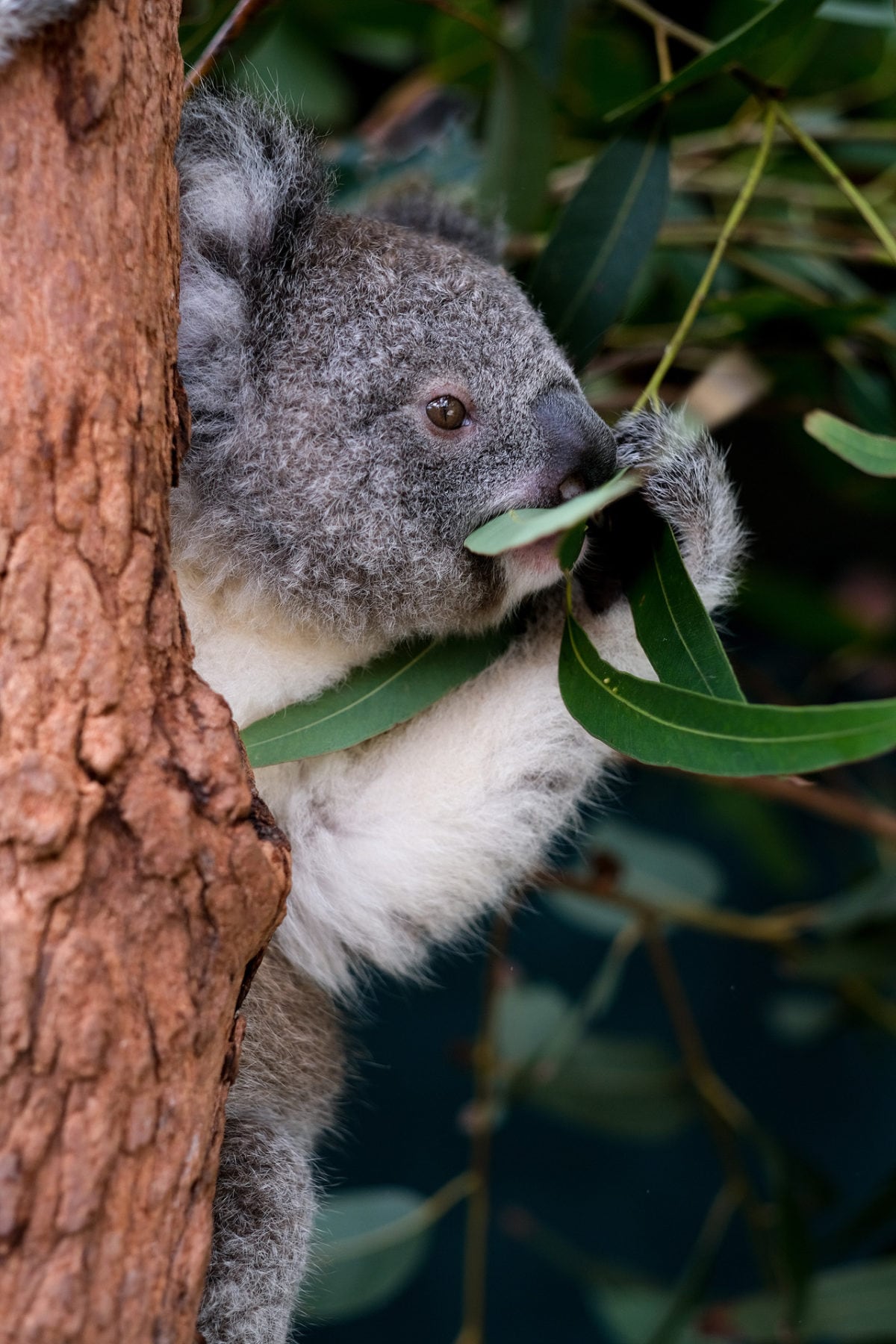
That population has now been studied by animal behaviour expert Dr Valentina Mella for more than three years. Koalas breed between August and February depending on where they live.
The Liverpool Plains population breeds towards the latter end of that period and Valentina was hoping to trial the new vaccine on the animals in April.
“But they’re too weak because of the drought,” she explains. “So we’ll put it off for now. We don’t want to put any more potential stresses on these animals.”
This is the first breeding season, during the time Valentina has been studying the population, that she hasn’t seen any babies. “It’s heartbreaking,” she says.
Her team’s surveys have found that many animals weakened by the drought have been succumbing to chlamydia and have been left sterile as a result, explaining, at least partly, the lack of offspring in the population this season.
Valentina’s research is helping to overturn one of the long-held beliefs about koalas – that they don’t drink. She has a study underway looking at the use of water stations that property owner Robert Frend has designed.
So far she’s recorded a lot of activity at the stations, and not just by koalas but also possums, gliders and many native birds.
Valentina’s team is also studying what sort of impact increasing temperatures will have on the physiology of koalas. Their body temperature runs at about 36°C, slightly less than humans, but they can cope with wider fluctuations than we can.
How much that internal temperature rises and falls in response to the surrounding ambient temperature is being assessed by the use of tiny, harmless pills that contain microelectronics administered to koalas caught for the study.
These are passed by the animals with no ill effect after about a week, but transmit useful internal body temperature readings via Bluetooth while ingested.
The concern is that if the koala’s internal temperature rises too much in response to ongoing high temperatures in the environment than the enzymes on which so many of their normal bodily activities rely, such as digestion, will be affected.
The koala, a much-loved Aussie icon
Ecologists joke that it’s easy to get money to study koalas because they’re so universally loved by the general public. Part of the reason why is because they have many features of an 18-month-old toddler, from their forward-facing eyes to the proportions of their limbs.
Whatever the reason for the overwhelming love of humans for koalas, the worldwide reaction to their plight during the fires is clear testament to that.
Cheyne, with the support of Sue, at the koala hospital plans to continue riding this strong wave of sentiment as much as possible.
“We’ve been invited to be part of the UN World Environment Day in New York in March on the impacts of Global Warming: wildfires on wildlife,” Cheyne says. “Representatives from the IUCN will be in attendance and we’re hoping to engage them in making changes to the conservation status of the koala.”
She also hopes to be able to exploit some deep philanthropic pockets while in the USA and attract funds of $100 million for the koala hospital to be able to buy large tracts of land in Australia of prime koala habitat.
Meanwhile, many researchers in ecology and conservation hope to also ride that huge wave of love for koalas, realising that protecting koala habitat also brings with it many more species sharing that habitat, from other mammals to reptiles, insects and plants. And so the koala is now being hailed by many scientists as an important umbrella species, worthy of high-level protection regardless of its legal conservation status.
Professor Hugh Possingham, chief scientist of the international conservation not-for-profit The Nature Conservancy is among them.
“Koalas, like many other species, prefer fertile moist habitats that are good for agriculture and cities,” he says. “And there are many other wonderful species in those locations that most people know nothing about; many species that will also benefit by protecting koala habitat.
“The plight of the koala is like the tip of the iceberg; it represents the plight of a thousand species that are suffering just as much from habitat loss and fire.”
This article is included in Issue 155 of Australian Geographic.

